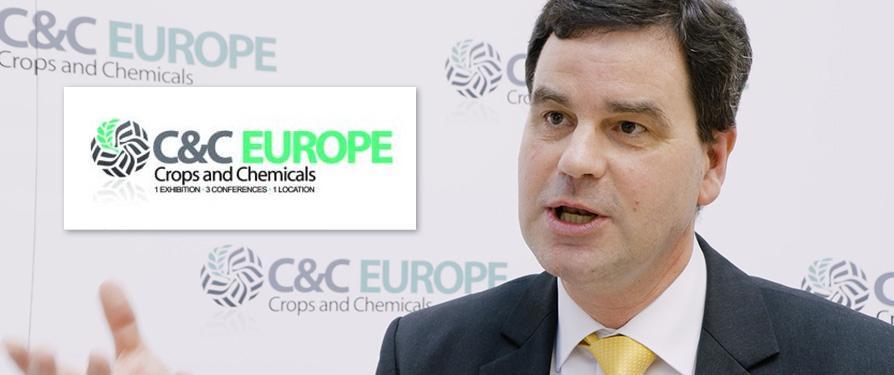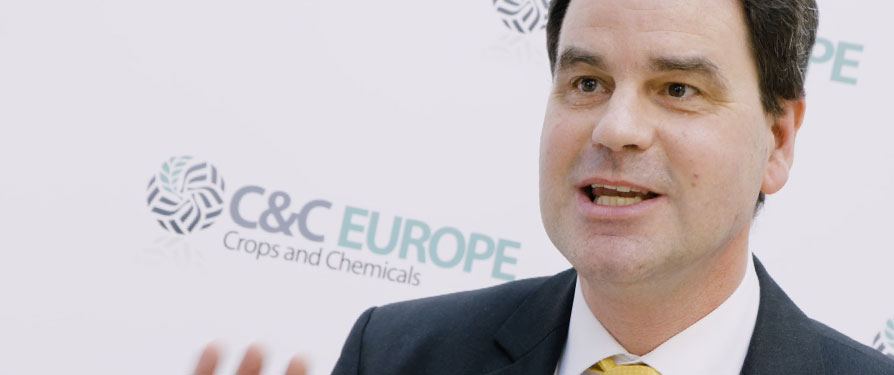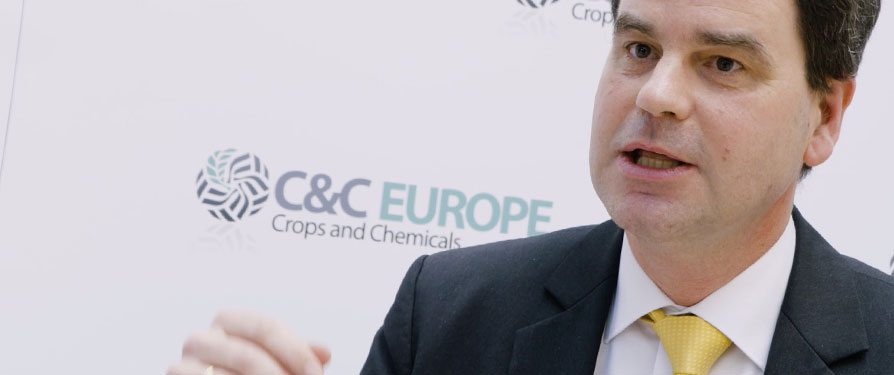Low risk substances in the EU
by Dr Bernd Brielbeck in Agrow’s Latin America supplement 2017
Date: 31.07.2017
The article summarizes the current legislative situation of the low risk substances in the EU, focusing on today’s challenges and prospects ahead. To read the article, please click on the link.
Dr Bernd Brielbeck, Senior Manager Regulatory Affairs, Agrochemicals and Biopesticides
_______________________________________________________________
New head of Chemicals business unit since July 2017
Thomas Roth has a PhD in food chemistry and is a certified expert for toxicology. He has been with SCC for more than 8 years now, leading the Toxicology group within the Regulatory Science business unit before taking the new responsibility this summer. Prior to joining SCC, Thomas Roth worked in the chemical industry for 10 years gaining his considerable professional experience in chemical toxicology and regulation.
_______________________________________________________________
Moving towards simpler registration conditions for biostimulants in the EU?
A critical review on current development of biostimulants by Dr Lars Huber in Agrow's supplement Biologicals 2017
Date: 30.05.2017
To view the article, please follow the link.
Dr Lars Huber, Head of Biostimulants, Fertiliser, IPM _______________________________________________________________
Latest developments in efficacy assessment in agriculture
by Dr Norbert Weissmann
Date: 15 February 2017
Please follow this link to view Norbert’s report on efficacy assessment in agriculture as presented at the Crop and Chemicals Europe in Berlin in February 2017. It provides an overview of current regulatory developments in efficacy, focusing on efficacy testing in 3-dimensional crops, data requirements for re-formulated products and key factors for efficacy testing of biopesticides and biostimulants.
For a brief summary of Norbert's presentation, please click here.
Dr Norbert Weissmann, Senior Manager Regulatory Affairs – Agrochemicals and Biopesticides, Head of Efficacy group
_______________________________________________________________
Low risk substances: a comprehensive overview
by Dr Bernd Brielbeck
Date: 15 February 2017
Click here to download Bernd’s guidance on low risk substances as presented at the Crop and Chemicals Europe in Berlin in February 2017. This presentation offers you a comprehensive overview on regulatory and political framework of low risk substances, guidance documents, handling of low risk criteria, hands-on experience and the outlook in the future. To view the synospsis of Bernd's presentation, please follow this link.
Dr Bernd Brielbeck, Senior Manager Regulatory Affairs, Agrochemicals and Biopesticide
_______________________________________________________________
Spotlight news: France undertakes steps to advance the development of biocontrol solutions
Date: 22 December 2016
Biocontrol products are not affected by the following bans:
• Ban on the use in amenity areas, forests, public roads, and walking paths accessible or opened to the public from 1st January 2017
• Ban on direct sales in self-service to amateurs from 1st January 2017
• Ban on placing on the market, delivery, use and holding for amateur use from 1st January 2019.
For more information, please view our newsletter Vol. 16, No. 5.
___________________________________________________________________
Biopesticides and the EU regulatory process
Date: 30.05.2016
Do biopesticides exist in EU legislation? What makes the approval process of biopesticides different from that of other active substances?
SCC’s Senior Manager Lars Huber reflects on these and related issues in his article in Agrow Biologicals 2016. Interested? Please click here
Dr Lars Huber, Head of Biostimulants, Fertiliser, IPM
_______________________________________________________________
Biopesticides market - a vision of a promising future?
Date: 30.05.2016
Dr Lars Huber, Head of Bio-stimulants, Fertiliser, IPM, shares his professional expertise on the future prospects of Biopesticides market in his interview in AgroNews. Read more
__________________________________________________________________________________
Hot topics in plant protection - interview with Bernd Brielbeck
Date: February 2016
www.informa-ls.com/event/cropsandchemicals2016
Applicability of new data requirements to applications for authorisation of plant protection products
Date: 06.02.2015
SCC has learnt that the legal services of the European Commission informed Member State authorities that the current understanding of the applicability of the new data requirements for product authorisations cannot be upheld.
The interpretation of article 4 of COMMISSION REGULATION (EU) No 284/2013 that Regulation (EU) No 545/2011 (i.e. the old data requirements) continued to apply only, where the respective application for product authorisation is submitted prior to 31 December 2015. The Commission stipulates now that this condition only holds for plant protection product applications, containing an active substance for which a dossier or supplementary dossier has been submitted prior to 31 December 2013, as is stated in the second part of article 4 (i.e. AIR 2 a.s.).
If the condition on active substance dossier submission is not fulfilled (i.e. for all AIR 3 a.s.), COMMISSION REGULATION (EU) No 284/2013 (i.e. the new data requirements) applies for all applications for product authorisations submitted as of 1 January 2014!
Summarising the above, the old data requirements continue to apply, only to applications for authorisation of plant products containing at least one AIR 2 a.s. (alone or in mixtures), if the application is submitted prior to 1 January 2016. In all other cases the new data requirements must be observed.
The legal services of the Member States are currently examining the view of the Commission.
For more information, please contact Dr. Albrecht Heidemann at This email address is being protected from spambots. You need JavaScript enabled to view it.
Renewal of Authorisations according to Article 43 of Regulation (EC) No 1107/2009 (SANTE/2010/13170 rev. 13)
Date: 03.09.2015
The application should include any new product data which are required due to new endpoints or criteria. The published Renewal Assessment Report is to be used to be aware of tests and studies. The EFSA conclusion shows where critical endpoints have been changed in the active substance renewal procedure.
Changes concerning authorised uses (e.g. amendment of the GAP) are only acceptable where it is necessary to comply with changes in the assessment of the active substance (e.g. new endpoints or restrictions). One exception is a non-significant formulation change according to SANCO/12638/2011.
Before the application, the so called “pre-notification-form” (as summarised in SANCO/12544/2014) is to be provided by the authorisation holder to the concerned Member State(s). A new outcome of this Guidance document is that the “pre-notification-form” should be submitted by the deadline for the submission of the supplementary dossier for the renewal of the active substance. An updated version should be submitted within 2 months following the publication of the EFSA-conclusion.
For the application to renew the authorisation, the EU PPP Application Management System is to be used. After every step in the procedure, it should be updated by the applicant or the concerned Member State.
For more information, please contact Dr. Albrecht Heidemann at This email address is being protected from spambots. You need JavaScript enabled to view it.
NEW EU LIST OF CANDIDATES FOR SUBSTITUTION
Date: 28.01.2015
PESTICIDES: EXPERTS ENDORSE NEW EU LIST OF CANDIDATES FOR SUBSTITUTION
A Commission proposal to establish an EU list of 77 candidates for substitution was endorsed on 27 January 2015 by EU Member State experts. Candidates for substitution (CfS) are pesticides for which national authorities need to carry out an assessment to establish whether more favorable alternatives to using the plant protection product exist, including non-chemical methods. The aim is to encourage more sustainable crop protection.
Please refer to http://europa.eu/rapid/press-release_MEMO-15-3743_en.htm for further information.
For more information, please contact Dr. Albrecht Heidemann at This email address is being protected from spambots. You need JavaScript enabled to view it.
News from Korea
Date: 20.08.2014
In Korea, the Act on Registration and Evaluation of Chemicals of Korea (also known as “K-REACH”) will come into force on 1 January 2015 and will from then on regulate the registration of chemicals.
‘AIR2’ ACTIVE SUBSTANCES – REQUEST OF MEMBER STATES FOR PRODUCT INFORMATION
Date: 07.08.2014
REQUEST FOR INFORMATION: PRODUCTS CONTAINING ‘AIR2’ ACTIVES TO BE SUPPORTED AT ARTICLE 43 RENEWAL.
Following renewal of approval for the ‘AIR2’ active substances (Reg. (EC) 1141/2010; http://eur-lex.europa.eu), the process of Article 43 (the renewal of authorisations for all products containing those active substances) will begin.
Conditions of approval for three active neonicotinoids changed
28.05.2013
The European Commission has changed the conditions of approval for the active neonicotinoid substances Clothianidin, Thiamethoxam and Imidacloprid, and prohibits the use and sale of seeds treated with plant protection products containing those active substances. The Authority has based its decision on the risk assessments for bees for these three actives. Member States are to amend or withdraw existing authorizations for plant protection products containing these three active substances by 30 September 2013. Periods of grace will be as short as possible and will expire on 30 November 2013 at the latest. Commission Implementing Regulation (EU) No. 485/2013 can be read here in its entirety.
Chlorfenapyr (PT8) included in Annex I of BPD
28.05.2013
The European Commission has approved the inclusion of Chlorfenapyr in Annex I of Directive 98/8/EC (the BPD) for PT 8 (wood preservatives). The complete decision can be read here.
Non-inclusion of Formaldehyde for PT 20 in Annex I of BPD
07.05.2013
The European Commission has voted not to include formaldehyde for PT 20 in Annex I of Directive 98/8/EC (BPD). According to Commission Decision 2013/204/EU, all authorizations will be withdrawn by 1 July 2015.
Provisional authorizations for new plant protection actives extended
07.05.2013
The EU Commission has extended the provisional authorizations for several new active substances for plant protection, which are currently under evaluation by the Commission. These are:
| Acequinocyl | Aminopyralid | Ascorbic acid |
| Flubendiamide | Gamma-cyhalothrin | Ipconazole |
| Metaflumizone | Orthosulfamuron | Pseudomonas sp. strain DSMZ 13134 |
| Pyridalil | Pyroxsulam | Spiromesifen |
| Thiencarbazone |
Topramezone |
Commission Implementing Decision 2013/205/EU extends the authorizations to 30 April 2015.
Paecilomyces fumosorseus strain FE 9901 approved by European Commission
03.05.2013
The European Commission has approved the inclusion of Paecilomyces fumosorseus strain FE 9901 in the annex of Commission Implementing Regulation (EU) No. 540/2011. You can read Commission Implementing Regulation (EU) No. 378/2013 here.
Bixafen added to Anned of Commission Implementing Regulation (EU) No. 540/2011
02.05.2013
The European Commission has approved the active substance bixafen, amending the Annexc to Regulation (EU) No. 540/2011 accordingly. Commissino Implementing Regulation (EU) No. 350/2013 can be read here.
DDAC fungicide - approval withdrawn
05.03.2013
The European Commission has withdrawn the approval for DDAC (Didecyldimethylammonium chloride). Originally approved for indoor uses on ornamental plants as a fungicide, herbicide, bactericide and algaecide, the decision to withdraw was made based on a submission of confirmatory data. The entire Commission Implementing Decision (EU) No. 175/2013 can be read here.
Extension of approval period for a number of active substances
17.12.2012
Commission Implementing Regulation (EU) No. 1197/2012 amends Implementing Regulation (EU) No. 540/2011 with regard to the extension of the approval period of active substances. These substances are: acetamiprid, alpha-cypermethrin, Ampelomyces quisqualis Strain: AQ 10, benalaxyl, bifenazate, bromoxynil, chlorpropham, desmedipham, etoxazole, Gliocladium catenulatum Strain: J1446, imazosulfuron, laminarin, mepanipyrim, methoxyfenozide, milbemectin, phenmedipham, Pseudomonas chlororaphis Strain: MA 342, quinoxyfen, S-metolachlor, tepraloxydim, thiacloprid, thiram and ziram. Read the entire document here.
Changes to certain heading of Annex I to Directive 98/8/EC
28.11.2012
The headings to all entries in Annex I of Directive 98/8/EC have been amended as follows:
- "Minimum degree of purity of the active substance" replaces "Minimum purity of the active substance in the biocidal product as placed on the market"
- "Deadline for compliance with Article 16(3), unless one of the exceptions indicated in the footnote to this heading applies" replaces "Deadline for compliance with Article 16(3) (except for products containing more than one active substance, for which the deadline to comply with Article 16(3) shall be the one set out in the last of the inclusion decision relating to its active substances)
The reasoning and justifications for these changes can be found in Commission Directive 2012/43/EU.
Two new inclusions and a non-inclusion in Annex I of the BDP
28.11.2012
The European Commission has recently made several decisions with regard to biocidal active substances.
Bifenthrin will not be included in Annex I. The non-inclusion decision for product type 18 is Commission Decision 2012/728/EU.
Nonanoic acid is now also included for PT 2, according to Commission Directive 2012/41/EU.
Hydrogen cyanide has been approved for all three product types - PT 8 (wood preservatives), PT 14 (rodenticides) and PT 18 (insecticides, acaricides and products to control other arthropods) - through Commission Directive 2012/42/EU.
cis-Tricos-9-ene (PT 19) approved for inclusion in Annex I of 98/8/EC
26.11.2012
The European Parliament and the EU Council have approved cis-Tricos-9-ene (PT 19) for inclusion in Annex I of Directive 98/8/EC. Certain provisions for the inclusion exist and can be read here:
Phosphane approved - Annex to Regulation No. 540/2011 amended
15.11.2012
The new active substance phosphane has been approved in according with Regulation No. 1107/2009. The Anned to Regulation No. 540/2011 has been amended accordingly. The decision can be read here.
Isopyrazam approved according to Regulation 1107/2009
09.11.2012
The European Commission has approved the active substance isopyrazam in accordance with Regulation 1107/2009. The Commission Regulation can be read here.
New Expiration Dates for a Number of Active Substances
19.09.2012
Commission Regulation (EU) No. 823/2012, derogating from Implementing Regulation (EU) No. 540/2011 as regards the expiry dates of the approval of a number of active substances, has been published. The change in date relates to substances for which approval expires before 14 June 2014; applicants could not give the three year' notice required under Article 15(1) of Regulation 1107/2009. The entire regulation detailing the active substances involved can be read here.
DDACarbonate for PT8 included in Annex I of 98/8
31.08.2012:
DDACarbonate has been approved for inclusion to Annex I of Directive 98/8/EC (BPD) for PT 8. Commission Directive 2012/22/EU can be read in its entirety here.
New submission dates for certain substances
31.08.2012
Commission Decision 2012/483/EU sets new dealines for the submission of dossiers for certain substances to be examined under Directive 98/8/EC (BDP). The following substances and product types are to be submitted by 30 September 2013:
Triclosan PT 2 RMS: DK
Triclosan PT 7 RMS: DK
Triclosan PT 9 RMS: DK
2-phenoxyethanol PT 3 RMS: UK
Conditions of Approval amended for several substances
17.07.2012
Commission Implementing Regulation (EU) No. 637/2012 amends the conditions of approval of the active substance iron sulphate, repellents by smell of animal or plant origin/tall oil crude and repellents by smell of animal or plant origin/tall oil pitch. In light of current scientific and technical knowledge, it was necessary to amend the conditions of approval as follows:
Iron sulphate: Particular attention is to be paid to: risk for operator; risk to children/residents playing on treated turf; risk to surface waters and to aquatic organisms. Confirmatory information regarding equivalence between the specifications of the technical material as commercially manufactured and those of the test material used in the toxicity dossiers is to be submitted by 1 May 2013.
Repellents by smell of animal or plant origin/tall oil pitch and crude: Particular attention is to be paid to: protection of operator, worker and bystander; risk to non-target species. Confirmatory information regarding (a) equivalence between the specifications of the technical material as commercially manufactured and those of the test material used in the toxicity dossiers is to be submitted by 1 May 2013; (b) the toxicological profile of repellents by smell of animal or plant origin/tall oil crude is to be provided to the Commission by 31 May 2014.
The entire Regulation can be read here.
Flufenoxuron (PT8) approved in Annex I of 98/8/EU
09.07.2012
The European Commission has approved Flufenoxuron for inclusion in Annex I of Directive 98/8/EC (Commission Directive 2012/20/EU) . The complete decision can be read here.
Regulation (EU) No. 528/2012 - Revised Biocidal Products Regulation
06.07.2012
Regulation (EU) No. 528/2012 has been publisched by the European Union. This revised Regulation replaces the Biocides Products Directive (BPD) 98/8/EC and will take effect starting 1 September 2013.
The new Regulation can be read here. More information regarding this revised Regulation will be provided in upcoming SCC Newsletters.
Amendments to conditions of approval for aluminium silicate, hydrolysed proteins and 1,4-diaminobutane (putrescine)
02.07.2012
Commission Implementing Regulation (EU) No. 571/2012 amends Reulgation 540/2011 with regards to the conditions of approval for the active substances aluminium silicate, hydrolysed proteins and 1,4-diaminobutane (putrescine). The new conditions can be read here.
Diphenylamine not approved
02.07.2012
Diphenylamine, which was already not included under Annex I of Directive 91/414/EC, has once again failed to receive approval for placement on the market according to Regulation (EC) No. 1107/2009.
Decision 2009/859/EC already gave reasons for the non-inclusion of Diphenylamine. A new notifier made an application for the active substance to the Irish RMS. This new application was unable to eliminate concerns regarding metabolites and the presence of nitrosamines. For this reason, the active substance is not approved. Decision 2009/859/EC has been repealed and replaced by Commission Implementing Decision (EU) No. 578/2012.
An important sidenote: The Regulation does not prohibit or prejudice the submission of a further application for diphenylamine pursuant to Article 7 of Regulation (EC) No. 1107/2009.
MRLs for a number of substances amended
21.06.2012
Commission Regulation (EU) No. 441/2012 amends Annexes II and III to Regulation (EC) No. 396/2005 regarding MRLS. The active substances involved are:
Bifenazate, Bifenthrin, Boscalid, Cadusafos, Chlorantraniliprole, Chlorothalonil, Clothianidin, Cyproconazole, Deltamethrin, Dicamba, Difenoconazole, Dinocap, Etoxazole, Fenpyroximate, Flubendiamide, Fludioxonil, Glyphosate, Metalaxyl-M, Meptyldinocap, Novaluron, Thiamethoxam, Triazophos
Authorisation restrictions for biocidal products containing Difethialone
21.06.2012
Denmark, Germany and Sweden have issued restrictions for biocidal products containing Difethialone. The restrictions are as follows:
Sweden:
Restricted to use by trained professionals with a license (Commission Implementing Decision 2012/318/EU)
Germany:
Restricted to use by licensed or trained professionals (Commission Implementing Decision 2012/317/EU)
Denmark:
Restricted to use by trained professionals with a license (Commission Implementing Decision 2012/316/EU)
Non-Inclusion of Naled in BPD
16.05.2012
Commission Decision 2012/257/EU concerning the non-inclusion of Naled for product type 18 in Annex I of the BPD Directive (98/8/EC) was published on 11 May 2012. Biocidal products of this product type containing Naled can no longer be placed on the market after 1 November 2012.
Inclusions and non-inclusions to the BPD
15.05.2012
Three active substances have been included in Annex I of the BPD. These are:
- Methyl nonyl ketone - Commission Directive 2012/14/EU
- Margosa extract - Commission Directive 2012/15/EU
- Hydrochloric acid - Commission Directive 2012/16/EU
In addition, the decision was made not to include the following active substance in Annex I of the BPD:
- Dichlorvos - Commission Decision 2012/254/EU




